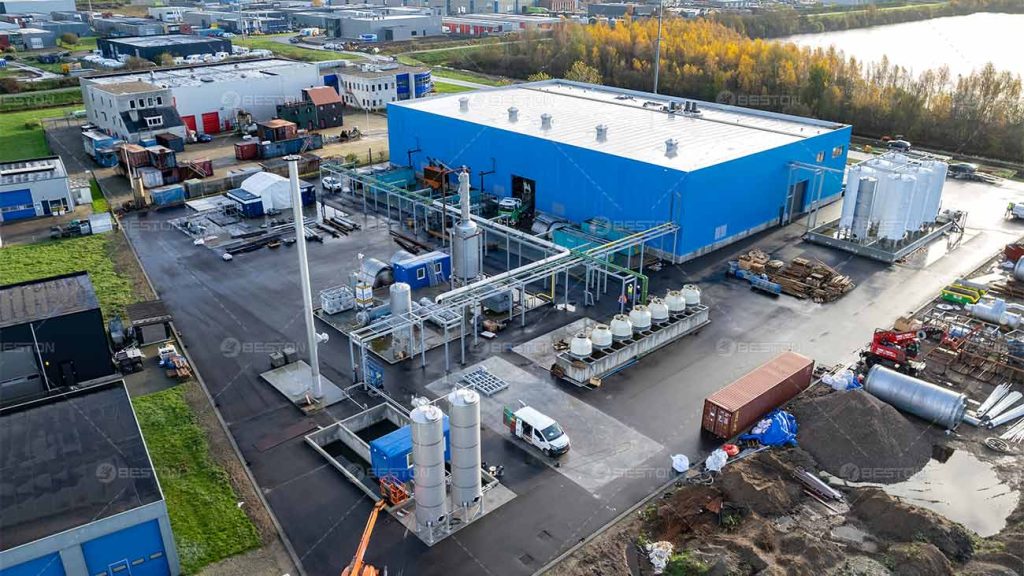Pyrolysis is a thermal decomposition process that occurs in the absence of oxygen, used to convert organic materials into valuable products such as oil, gas, and carbon black. In modern waste management and recycling industries, pyrolysis plays a vital role in reducing landfill waste while generating renewable energy sources. Two of the most commonly pyrolyzed materials are plastic and rubber, particularly waste tires. In this article, we will explore the pyrolysis processes for these materials, the technology behind them, and their environmental and economic benefits.
Pyrolysis Of Waste Plastic Materials
Plastic waste has become one of the most pressing environmental issues of the 21st century. Billions of tons of discarded plastics end up in landfills or oceans, where they take hundreds of years to decompose. The waste plastic pyrolysis plant offers a sustainable and profitable solution to this problem. Through pyrolysis, waste plastic is heated in a reactor at temperatures ranging from 350°C to 500°C without oxygen, leading to the breakdown of polymer chains.
The primary products of plastic pyrolysis are pyrolysis oil, carbon black, and combustible gas. The oil can be used as an industrial fuel or further refined into diesel. The gas produced during the process can be recycled within the system to provide the heat required for continuous operation, making the system highly energy-efficient. The remaining carbon black is useful in manufacturing pigments, tire rubber, and construction materials.
Modern pyrolysis systems, such as the continuous pyrolysis plant, enhance productivity and safety. These systems allow for uninterrupted feeding and discharging, reducing labor costs and downtime. With automated control and emission treatment technologies, continuous pyrolysis ensures environmental compliance and consistent product quality.

Pyrolysis Of Waste Rubber And Tyres
Waste tires are another challenging waste stream. Every year, millions of tons of tires are discarded, posing serious environmental risks due to their non-biodegradable nature. Fortunately, the waste tyre pyrolysis plant offers an effective method to recycle rubber and convert it into valuable resources. The pyrolysis process for rubber materials is similar to that of plastics but often requires slightly higher temperatures and longer retention times due to the complex structure of rubber polymers.
During tire pyrolysis, the rubber is heated in an oxygen-free chamber, causing it to decompose into tire oil, steel wire, carbon black, and syngas. The recovered tire oil can be sold directly as an industrial fuel or further refined. The steel wire can be reused in metal industries, while the carbon black can be processed and sold as a reinforcing agent in rubber production. The process not only reduces the environmental burden of waste tires but also contributes to circular economy principles by recovering materials that would otherwise be wasted.
An additional advantage of modern tire pyrolysis systems is the high level of automation. Advanced pyrolysis equipment incorporates automatic feeding, discharging, and emission control, ensuring minimal manual intervention and cleaner operations. These systems are designed to comply with international emission standards, making them suitable for operation in various countries with strict environmental regulations.

Environmental And Economic Benefits
Pyrolysis offers multiple environmental and economic benefits. By converting waste plastics and tires into valuable products, the process significantly reduces the volume of waste sent to landfills. Moreover, the pyrolysis oil produced serves as an alternative to fossil fuels, helping to lower dependence on petroleum-based energy. The carbon black and steel wire recovered can be reused, promoting resource efficiency and reducing the need for virgin materials.
From an economic perspective, a well-designed pyrolysis plant can provide a steady revenue stream through the sale of oil, gas, and solid byproducts. In particular, the continuous pyrolysis plant offers enhanced efficiency and scalability, making it ideal for large-scale operations. Many countries are now encouraging the establishment of such facilities as part of their sustainable waste management strategies.
Conclusion
The pyrolysis of waste plastics and tires represents a vital step toward a cleaner and more sustainable planet. Both processes convert otherwise polluting waste into useful products, supporting the circular economy and reducing greenhouse gas emissions. With continuous innovations and reliable manufacturers like Beston Group, the future of pyrolysis technology looks bright. Adopting pyrolysis systems is a powerful way to transform waste into value while protecting the environment for future generations.